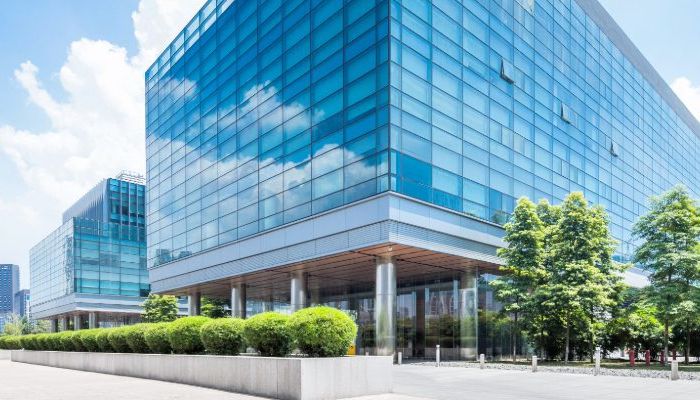Facility managers don’t have to struggle to keep up with all the moving parts of a building solely on paper. We have the technology now that can ensue our buildings run smoothly and that we never forget a detail.
Computers are excellent at analyzing large amounts of data and remembering little details that humans often forget. Through things like machine learning and a CAFM platform, companies can leverage the power of data to help run their buildings efficiently.
Some people use the term interchangeably with integrated workplace management systems (IWMS), but CAFM software doesn’t offer quite the workflow and capabilities. Nevertheless, it can be tough to distinguish a CAFM solution from other types of management systems, but there is a crucial difference.
CAFM systems are a highly visual platform. They combine things like CAD images with data and data analysis to give facility managers a full suite of ways to view and assess assets. It has become its own niche in management.
The CMMS offers core functionality for the system, while EAM is a long term planning system for scale and enterprise. IWMS is excellent for people who work across many real-estate and facilities areas who manage a portfolio of facilities, a CAFM system is mostly concerned with the physical building itself.
How Does Computer-Aided Facility Management Work?
CAFM software uses information and data to help facility managers plan and execute maintenance for the building and real estate. Every part of the day to day operations falls under this type of management, and so a CAFM solution helps managers wrangle those small details. It coordinates the physical workspace with the people and operations.
The software is a comprehensive solution for handling the day to day operations of the building. It has many different functions and tools to ensure managers succeed. Let’s take a look at a few of them.
CAFM Information Technology
CAFM uses things like CAD to provide higher-tech visuals of the building. CAFM is a data-centric approach, using continuous data to update predictions for operations. Data-centric models are a crucial part of managing facilities within the 21st century.
Interactive floor plans and pictures of internal systems are all things that provide managers more information and an easier time scheduling the overall care of the building while considering occupancy, employee movement, and other considerations that make up the unique company ecosystem.
How CAFM Can Help With Maintenance?
Much like CMMS, CAFM offers facility managers the chance for building maintenance management in one centralized location. Managers schedule routine repairs and can find times where downtime will be less obtrusive. They can also see asset conditions through modules that make the management process more intuitive.
These modules utilize the real-time data from the Internet of things to help with scheduling and ensure that maintenance happens well before there’s an emergency. This cuts down on operational bottlenecks and helps managers manage a backlog of maintenance management needs.
In some cases, CMMS systems are used in conjunction with CAFM for precisely this focus on computer learning and data processing. The option to have computers analyze data patterns and make predictions is a huge consideration and one way that companies are cutting down on overhead costs.
Can CAFM Help With Building Administration?
CAFM can also help with building administration. Handling the physical infrastructure is a significant tax on resources, and a computer system that takes care of it is a boon to the process. They can be linked to things like the HVAC system, lights, or any other system that’s sometimes forgotten.
Remote management takes away the worry about having the building occupied when the facilities manager isn’t in the building. Team meetings that happen on the weekend, early morning work schedules – all that can be monitored remotely with a simple mobile phone.
It also offers automated monitoring of your resources. You’ll know if your usage changes over a period of time and whether that’s a natural occurrence or a potential issue that will require maintenance. It improves safety and offers businesses the chance to save money and provide a more secure work environment.
CAFM is more than just these fancy features. The features facilitate the day to day management of the building and help ensure that there’s consistency in operations, and the environment has frictionless management. It’s labor-saving and ensures that no details are missed.
What Areas Can CAFM Help Improve?
There are quite a few areas that CAFM affects. While an integrated workplace management system may be the newest technology for building management, CAFM still provides niche options for management. Here are a few:
Space management – CAFM allows managers to understand the natural flow of the building and optimize space. You don’t have to manage a frustrating paper system or overbook during a busy season.
Capital Project Management – For large scale projects, a CAFM can be a fantastic tool to ensure that projects are finished on schedule and that the whole project stays on track.
Asset management – There are lots of assets within your building, and a coherent and centralized system is vital to optimizing their use.
Risk management – With a new era of compliance and leasing restrictions, a CAFM may be able to ensure your building is compliant without a huge tax on your resources or productivity.
Day to day operations – the moment the lights come on in the morning to the second everything is closed for the weekend, a CAFM can be a great way to manage those little details and improve workflow across the board.
What Kinds of Assets does CAFM Manage?
What assets are involved in this software? You know it’s the building itself, but it’s also physical assets inside the building:
- Equipment
- Furniture
- Infrastructure
- Space Management
All this, among other things. The software also manages data forms to help manage those assets. Different data points provide a complete picture of what’s going on inside the building and build a comprehensive plan for management:
- Leases
- Chain of Custody
- Condition
- Usage
- Costs
- Energy
- People
And a whole suite of other data points. The system feeds on this data, so the software offers a full spectrum of options.
Why CAFM Transformed Facility Management?
Before the age of computer-assisted facility management, it was a lot of running around and trying to put out fires before they got bad. Humans aren’t great at handling all the little details, and we aren’t very good at noticing overarching patterns that happen with such expansive data points.
CAFM was the first platform of its kind. It empowered users to make better, data-driven decisions, and with things like AutoCAD integration, facility managers can actually see their buildings in use.
As data expanded and our understanding of intelligence got better, the platform expanded to become more comprehensive solutions such as IWMS. Now, facility management has a ton of options that can ensure a building never misses a second of preventive maintenance, and the workflow happens seamlessly.
What Are The Benefits Of CAFM?
Having a platform that makes planning easier is a benefit in itself. However, specifically, CAFM helps with quite a few things.
Centralizes All Your Data
Having hand written post-it notes, clipboards and spreadsheets to manage work is not the best way to manage your facility maintenance programs and is not the best way to control costs or manage a business. Instead, a CAFM brings all your data to a point and helps ensure that it provides those insights managers need.
Reports Made Simple
For compliance purposes, you must have access to logical software and reports. With the right type of software, everything you need is right at the click of a button – work orders, maintenance, usage assessments, energy usage, and anything else you could need to remain compliant on a lease, for regulations, or for insurance purposes.
Straightforward Visualization
CAD allows a full perspective of the building, increasing management awareness, and simplifying the asset management processes. Images are a great way to see into a building and ensure that its operations are running smoothly. You can also use it to mock up how small (or large) changes to the infrastructure could affect its use.
How Does CAFM Scale?
A considerable benefit of CAFM is the ability to scale through lifecycle management. When you embark on a capital management project, for example, a CAFM can help keep everything on track. It provides a facility manager with the ability to mock up potential changes, see those changes through, and alter maintenance processes to suit.
This scale is so essential as buildings age and facilities change hands. With records from this type of software, the overall implementation of the building’s maintenance can change hands or expand to suit new circumstances.
Implementing Facilities Management With CAFM
Most large scale business operations have moved on from traditional facility management, but if you haven’t, it’s time. Starting with a CAFM can be an excellent way to ensure that details are handled, and data provides consistent decision making.
A CAFM puts all your data into one centralized place and helps you make better decisions based on that data. It also nudges you towards preventive maintenance and helps reduce downtime. As you handle those disruptive practices, you may end up saving your business a ton of money in overhead costs.
Some of your business’s highest costs are directly related to the building. This software helps ensure that costs don’t creep up and that day to day operations are handled as frictionless as possible. This software can get you pretty close to that perfect record.










